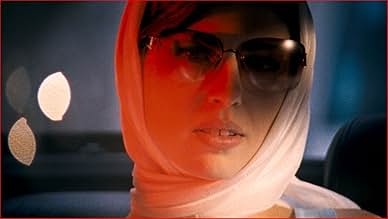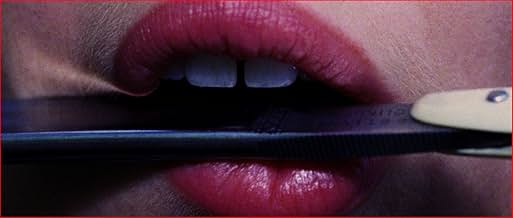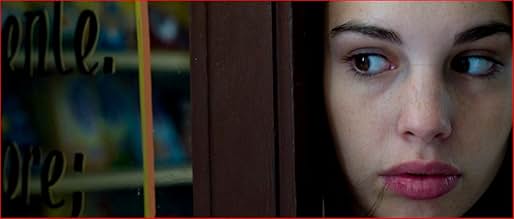IMDb RATING
6.1/10
6.8K
YOUR RATING
As a young girl Ana was a rebellious child. She was also tormented by images of death and a shadowy, ominous figure in black. Now an adult, she is once again tormented by shadowy, other-worl... Read allAs a young girl Ana was a rebellious child. She was also tormented by images of death and a shadowy, ominous figure in black. Now an adult, she is once again tormented by shadowy, other-worldly forms.As a young girl Ana was a rebellious child. She was also tormented by images of death and a shadowy, ominous figure in black. Now an adult, she is once again tormented by shadowy, other-worldly forms.
- Directors
- Writers
- Stars
- Awards
- 7 wins & 6 nominations total
Charlotte Eugène Guibeaud
- Ana adolescente
- (as Charlotte Eugène Guibbaud)
Biancamaria D'Amato
- La mère
- (as Bianca Maria D'Amato)
- Directors
- Writers
- All cast & crew
- Production, box office & more at IMDbPro
Featured reviews
Yeah, I'm really not a fan of these 'style over substance' style movies. I saw this film's follow-up, THE STRANGE COLOUR OF YOUR BODY'S TEARS, before I saw this, so I had some idea of what to expect, but still this film's almost entire lack of storyline and coherent narrative was enough to finish me off. I get what the filmmakers are doing, and I'm a huge fan of the giallo genre, but this just smacks of pretentiousness and comes across as completely pointless.
AMER tells the visual story of a girl whose life is chronicled in various parts. She's subjected to a terrifying experience as a child, and then her perfect life as an adult is brought into jeopardy by the intervention of a mysterious stranger. There's no more to it than that; this is an entirely visual production, with thousands of cuts and edits designed to make the most beautiful experience ever.
The images are great, and the soundtrack is hugely evocative, but the whole thing lacks so much substance that it's a real chore to sit through and it seems to go on forever and ever. This is from a guy who's been enjoying the art films of the likes of Werner Herzog and Kim Ki-duk. But AMER is a case of the 'Emperor's new clothes'; the lights are on, and they're very pretty, but nobody's home.
AMER tells the visual story of a girl whose life is chronicled in various parts. She's subjected to a terrifying experience as a child, and then her perfect life as an adult is brought into jeopardy by the intervention of a mysterious stranger. There's no more to it than that; this is an entirely visual production, with thousands of cuts and edits designed to make the most beautiful experience ever.
The images are great, and the soundtrack is hugely evocative, but the whole thing lacks so much substance that it's a real chore to sit through and it seems to go on forever and ever. This is from a guy who's been enjoying the art films of the likes of Werner Herzog and Kim Ki-duk. But AMER is a case of the 'Emperor's new clothes'; the lights are on, and they're very pretty, but nobody's home.
When I included Amer in a short list of films I was eagerly anticipating in 2010, I wrote that I was looking forward to "ostentatious cameras that go on a discovery of psychosexual nightmares, a stylish violence, jazzy grooves". I'm a big fan of Italian genre cinema, especially gialli, for me they fulfill the needs comic-books do in others. When I say I'm a fan, I mean that when Stelvio Cipriani's song La Polizia Ha Le Mani Legate (originally part of Cipriani's score for Roma Violenta) finished playing in Amer's end credits, I rummaged through my cd collection to find it.
But, even as I was writing that a few months ago, Amer already had a reputation as more than a giallo film, "arthouse" people insisted, which intrigued me more. So, does Amer reward the giallo fan with the wink of film reference, or is the giallo only the trope of an expression intended for a different audience?
To go back to my appreciation for the giallo as comic book, it's the mentality of the colorful panel that appeals to me, the vivid bits of casual violence to strike a chord and be forgotten after the next page, the indulgence on something that reaches only as deep as the excitement it provides. To put so much effort or go through all the trouble for the pleasure of something momentary, this exaggeration is essentially the province of youth, where the fling of a few days burns with the passion of true love. In this sense, the giallo rejuvenates me.
That in mind, Amer is at once an apotheosis and a keelhaul of the panel, an overkill of shots capturing small details, of closeups of eyes or reflections or bits of the human anatomy. It's a world come alive through the senses, by a child overhearing conversations from behind closed doors, or a young girl feeling the first tingling of a booming sexuality in her skin. There's very little dialogue and this appeals to me, because the convoluted plots were always my least favorite aspect of the giallo.
But if Amer is not pushed forward by people talking, does it establish other means of communicating this story of sexual awakening and repression, the schism that follows from a child discovering a cruel world or a teenager being denied that discovery on her own?
I'll say yes, but with reservations. Still, what's important for me, is the tweaking of the filmed image to see is there another way to make cinema, the nature of an experiment whose results can only be appreciated in the future. Better said, if we peel a cabbage we get the core, but if we peel an onion? Some will say we get nothing, but we've done the peeling and we've transformed the onion, so can we really say that? The cinema of Amer is that peeling.
Two things particularly stand out for me here in this cinematic depiction of trauma.
One is the root of it, seen through the kaleidoscope of a child's awestruck imagination. A child's feverish nightmare shot in the otherworldly cyans and magentas of Mario Bava, where disfigured old men and strange hooded figures reach out to the camera. This is probably the most horrific part of the movie.
The other is the cause and effect of the teenage girl's sexual awakening. The directors explore this with a marvellous sense of exaggeration, of a complete fetishization of sexuality and the human body. When the young girl comes across a group of bikers, we get blurry closeups of chrome, of throats undulating or the trickle of perspiration, of buckles and boots. The girl approaches them almost solemnly, clinging to her short summer dress, with an air of fearful apprehension and the irrepressible instinct of a moth drawn to a flame. Before her discovery can be consumated, her overbearing mother shows up to slap her for the offense and take her away. Simple, crude some may say, but brilliant in getting a point across.
It's in the film's conclusion that we find the giallo lurking in the shadows of a ruined mansion, where the black-gloved hand of the killer slashes the dark. The directors give us the killing hand but with a twist, another contraption of the giallo.
What about the intended audience though? I feel that Amer will appeal more to fans of the sexual psychodrama of Repulsion, than the fan who will seek out a film like Amuck for the profound pleasure of watching giallo queens Barbara Bouchet and Rosalba Neri make out on the same bed. The lurid tradition of Sergio Martino is only honored in the selection of epochal musis by the likes of Bruno Nicolai, Morricone or Cipriani.
But, even as I was writing that a few months ago, Amer already had a reputation as more than a giallo film, "arthouse" people insisted, which intrigued me more. So, does Amer reward the giallo fan with the wink of film reference, or is the giallo only the trope of an expression intended for a different audience?
To go back to my appreciation for the giallo as comic book, it's the mentality of the colorful panel that appeals to me, the vivid bits of casual violence to strike a chord and be forgotten after the next page, the indulgence on something that reaches only as deep as the excitement it provides. To put so much effort or go through all the trouble for the pleasure of something momentary, this exaggeration is essentially the province of youth, where the fling of a few days burns with the passion of true love. In this sense, the giallo rejuvenates me.
That in mind, Amer is at once an apotheosis and a keelhaul of the panel, an overkill of shots capturing small details, of closeups of eyes or reflections or bits of the human anatomy. It's a world come alive through the senses, by a child overhearing conversations from behind closed doors, or a young girl feeling the first tingling of a booming sexuality in her skin. There's very little dialogue and this appeals to me, because the convoluted plots were always my least favorite aspect of the giallo.
But if Amer is not pushed forward by people talking, does it establish other means of communicating this story of sexual awakening and repression, the schism that follows from a child discovering a cruel world or a teenager being denied that discovery on her own?
I'll say yes, but with reservations. Still, what's important for me, is the tweaking of the filmed image to see is there another way to make cinema, the nature of an experiment whose results can only be appreciated in the future. Better said, if we peel a cabbage we get the core, but if we peel an onion? Some will say we get nothing, but we've done the peeling and we've transformed the onion, so can we really say that? The cinema of Amer is that peeling.
Two things particularly stand out for me here in this cinematic depiction of trauma.
One is the root of it, seen through the kaleidoscope of a child's awestruck imagination. A child's feverish nightmare shot in the otherworldly cyans and magentas of Mario Bava, where disfigured old men and strange hooded figures reach out to the camera. This is probably the most horrific part of the movie.
The other is the cause and effect of the teenage girl's sexual awakening. The directors explore this with a marvellous sense of exaggeration, of a complete fetishization of sexuality and the human body. When the young girl comes across a group of bikers, we get blurry closeups of chrome, of throats undulating or the trickle of perspiration, of buckles and boots. The girl approaches them almost solemnly, clinging to her short summer dress, with an air of fearful apprehension and the irrepressible instinct of a moth drawn to a flame. Before her discovery can be consumated, her overbearing mother shows up to slap her for the offense and take her away. Simple, crude some may say, but brilliant in getting a point across.
It's in the film's conclusion that we find the giallo lurking in the shadows of a ruined mansion, where the black-gloved hand of the killer slashes the dark. The directors give us the killing hand but with a twist, another contraption of the giallo.
What about the intended audience though? I feel that Amer will appeal more to fans of the sexual psychodrama of Repulsion, than the fan who will seek out a film like Amuck for the profound pleasure of watching giallo queens Barbara Bouchet and Rosalba Neri make out on the same bed. The lurid tradition of Sergio Martino is only honored in the selection of epochal musis by the likes of Bruno Nicolai, Morricone or Cipriani.
Leaving viewers in the dark about the true inclination of a piece is commonplace in Art Cinema. I do agree that most mainstream films now are over explained and blatant with whatever plot device is being utilised. However, while i think it's good for the viewer to give a little of themselves to work at understanding a director's vision this was a little much.
The visuals are beautiful. Some of the little touches exquisite (the way the teenage Ana hypnotically chews on a strand of her hair was simultaneously abhorrent and alluring) I'm sure there is an intricate back-story here with allusions to Sigmund Freud etc (from what i've heard there is a portrait of him in the house, however i didn't see it) but i'm not hugely interested in discovering what it is. A little explanation can make all the difference. Some connection with the audience would have helped this piece along.
In the end, the plot made little difference. Its slightness WAS the film for me. I enjoyed the inspired jump-cuts and the obsession with body hair and sexual gratification. I was amused and disturbed. That's fine. But the film used these devices to the point of saturation. Overkill. Egotism.
I may be missing the point here, so be it. This film stands well as a piece of visual art. The vivid blue Mediterranean, the dark haired women, the gorgeous cinematography in general. But it is missing something as a film and thus with narrative. It would have worked FAR better as a short 15 minute piece.I would like to say i'd re-watch this and get to grips with what the director is trying to say, but that would be a lie. Certainly this film is nothing like the Giallo films of Fulci and Argento that i have seen so far in my admittedly limited viewing.
The visuals are beautiful. Some of the little touches exquisite (the way the teenage Ana hypnotically chews on a strand of her hair was simultaneously abhorrent and alluring) I'm sure there is an intricate back-story here with allusions to Sigmund Freud etc (from what i've heard there is a portrait of him in the house, however i didn't see it) but i'm not hugely interested in discovering what it is. A little explanation can make all the difference. Some connection with the audience would have helped this piece along.
In the end, the plot made little difference. Its slightness WAS the film for me. I enjoyed the inspired jump-cuts and the obsession with body hair and sexual gratification. I was amused and disturbed. That's fine. But the film used these devices to the point of saturation. Overkill. Egotism.
I may be missing the point here, so be it. This film stands well as a piece of visual art. The vivid blue Mediterranean, the dark haired women, the gorgeous cinematography in general. But it is missing something as a film and thus with narrative. It would have worked FAR better as a short 15 minute piece.I would like to say i'd re-watch this and get to grips with what the director is trying to say, but that would be a lie. Certainly this film is nothing like the Giallo films of Fulci and Argento that i have seen so far in my admittedly limited viewing.
Cattet and Forani are a Belgian couple who have made five short films together. This is their first feature. Divided into three parts, it focuses on childhood, adolescence, and womanhood in the life of Ana. Each moment is seen symbolically, very sensually, but without much discernible narrative, in a marvelous display of stylized visuals (in intensely colored and multiple-filtered 35 mm. images). There is a powerful, hit-you-over-the-head soundtrack. The material is fragmented, beginning with the images of eyes, presented in long horizontal rectangles. A girl is browbeaten by parents, or a couple anyway, whom she witnesses through a keyhole, shut in, and comes upon having sex. Later she also contemplates the hardening corpse of her dead grandfather. White grains under a bed. An ant. A spider. Loud booming sounds, which unfortunately in the Museum of Modern Art screening room blended with the underground sound of a rumbling subway line.
Later, the girl grows up and the film, which begins with dark interiors in an old house, switches to a sunny, Mediterranean, outdoor world. We are near Menton (credits indicate later), on the margin between the French and Italian Rivieras, along the Cote d'Azûr or the Amalfi Drive. A gang of motorcyclists with leather and metal and tight jeans stand by the road with their cycles. But we see only bits and pieces of them.
And this goes on and on, never ceasing to be beautiful, lushly noisy, sensual, fragmented, narrative-free. Amer, which means "bitter" in French, may be ideal for those who like to revel in "pure cinema."
There is one trouble though, and that this film tends to turn neurosis -- or desire, whatever it's about, which isn't altogether clear to me -- into a fashion shoot. It's said to mimic the style of Italian "giallo," pulp fiction, or the Daria Argento kind of stuff, and Italian movie music is among the many sonic allusions. Initially the feel is very much like something Spanish, or the Guillermo del Toro of Pan's Labyrinth. But as time goes on the impression of a fashion shoot undercuts the evocation of dream and fantasy through visual means. What might have been edgy, subtle, and memorable turns to chic kitsch. Or slick horror, when someone plays around with a straight razor in a threatening and suggestive manner as in Dali-Buñuel's Andalusion Dog.
While I and others with me found Amer hard going, despite its accomplished visuals, a British online reviewer called Alan Jones (reporting on the London Film4 Frightfest) was entranced, delighted with the evocation of Italian "gialli." He concludes, speaking of the late segment he explains is a walk along the highway to the hairdresser: "Charlotte Eugene-Guibbaud couldn't be more tantalizing as the hair-chewing Lolita either with her mini-dress hem flapping against her knickers at crotch-level. Maria Bos is pure Florinda Bolkan in the eyes-reflected-in-knife-blade finale, the portion where debts to A LIZARD IN A WOMAN'S SKIN are felt the most. Shimmering with a lush vibrancy and utilizing recycled Ennio Morricone, Bruno Nicolai, Stelvio Cipriani and Adriano Celentano music within its superb sound design, AMER carries an erotic and exotic charge I never thought could be replicated again outside such essential gialli as STRIP NUDE FOR YOUR KILLER or the classic Dario Argento Animal Trilogy. AMER is a faultless masterpiece, so just relax and breathe in the heady perfume of Cattet and Forzani's dazzling lady in black."
This glowing report shows the potential Amer has as a festival film that may, since Magnolia has bought it, get theatrical attention. However, in my view Cattet and Forani have not essentially moved up from their five short films to a feature, because this is merely short-film material spread out over ninety minutes, divided into three, and diced up into many edited visual fragments. A series of stylish pastiches does not a feature make. The conception is too slight and too fragmented to work as a real feature film. Nice eye candy though, and as Jones says, the sound design also is definitely "lush."
Shown as part of the New Directors/New Films series co-sponsored this year by MoMA and the Film Society of Lincoln Center and sown in New York at both the Walter Reade Theater and MoMA's Titus Theater in April 2010. Amer has been shown at many festivals between September 2009 and spring 2010.
Later, the girl grows up and the film, which begins with dark interiors in an old house, switches to a sunny, Mediterranean, outdoor world. We are near Menton (credits indicate later), on the margin between the French and Italian Rivieras, along the Cote d'Azûr or the Amalfi Drive. A gang of motorcyclists with leather and metal and tight jeans stand by the road with their cycles. But we see only bits and pieces of them.
And this goes on and on, never ceasing to be beautiful, lushly noisy, sensual, fragmented, narrative-free. Amer, which means "bitter" in French, may be ideal for those who like to revel in "pure cinema."
There is one trouble though, and that this film tends to turn neurosis -- or desire, whatever it's about, which isn't altogether clear to me -- into a fashion shoot. It's said to mimic the style of Italian "giallo," pulp fiction, or the Daria Argento kind of stuff, and Italian movie music is among the many sonic allusions. Initially the feel is very much like something Spanish, or the Guillermo del Toro of Pan's Labyrinth. But as time goes on the impression of a fashion shoot undercuts the evocation of dream and fantasy through visual means. What might have been edgy, subtle, and memorable turns to chic kitsch. Or slick horror, when someone plays around with a straight razor in a threatening and suggestive manner as in Dali-Buñuel's Andalusion Dog.
While I and others with me found Amer hard going, despite its accomplished visuals, a British online reviewer called Alan Jones (reporting on the London Film4 Frightfest) was entranced, delighted with the evocation of Italian "gialli." He concludes, speaking of the late segment he explains is a walk along the highway to the hairdresser: "Charlotte Eugene-Guibbaud couldn't be more tantalizing as the hair-chewing Lolita either with her mini-dress hem flapping against her knickers at crotch-level. Maria Bos is pure Florinda Bolkan in the eyes-reflected-in-knife-blade finale, the portion where debts to A LIZARD IN A WOMAN'S SKIN are felt the most. Shimmering with a lush vibrancy and utilizing recycled Ennio Morricone, Bruno Nicolai, Stelvio Cipriani and Adriano Celentano music within its superb sound design, AMER carries an erotic and exotic charge I never thought could be replicated again outside such essential gialli as STRIP NUDE FOR YOUR KILLER or the classic Dario Argento Animal Trilogy. AMER is a faultless masterpiece, so just relax and breathe in the heady perfume of Cattet and Forzani's dazzling lady in black."
This glowing report shows the potential Amer has as a festival film that may, since Magnolia has bought it, get theatrical attention. However, in my view Cattet and Forani have not essentially moved up from their five short films to a feature, because this is merely short-film material spread out over ninety minutes, divided into three, and diced up into many edited visual fragments. A series of stylish pastiches does not a feature make. The conception is too slight and too fragmented to work as a real feature film. Nice eye candy though, and as Jones says, the sound design also is definitely "lush."
Shown as part of the New Directors/New Films series co-sponsored this year by MoMA and the Film Society of Lincoln Center and sown in New York at both the Walter Reade Theater and MoMA's Titus Theater in April 2010. Amer has been shown at many festivals between September 2009 and spring 2010.
Act 1 is brilliant - a terrifying, sensual, nightmarish homage to Dario Argento. Act 2 is boring filler. Act 3 has a nasty torture scene and is better than the second act, but still feels pointless.
Did you know
- TriviaShot on 16mm film and then blown up to 35mm to recreate the grainy effect of 1970s exploitation movies.
- ConnectionsReferenced in Lost in Vienna, Austria (2013)
- How long is Amer?Powered by Alexa
Details
Box office
- Budget
- €880,000 (estimated)
- Runtime
- 1h 30m(90 min)
- Color
- Sound mix
- Aspect ratio
- 2.35 : 1
Contribute to this page
Suggest an edit or add missing content





















